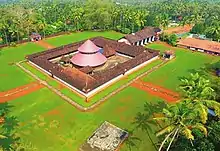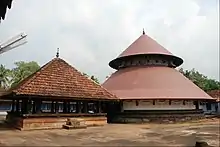Goda Ravi
Goda Ravi (fl. 905/06–c. 943/44 AD[4]) was a Chera Perumal king of medieval Kerala, south India.[5] The Chola relations with the Chera Perumals were consolidated during the rule of Goda Ravi. Records mention a number of Kerala military personnel serving with Chola prince Rajaditya in the Tamil country.[6] An inscription mentioning Goda Ravi from Nedumpuram Thali, Wadakkanchery is one of rare Chera Perumal inscriptions which give both the regnal year and another era (Kali Year) at the same time.[5]
| Goda Ravi | |
|---|---|
| Ruler of Chera Perumal Kingdom | |
| Reign | 905/06–c. 943/44 AD[1] |
| Predecessor | Goda Goda (or) Kerala Kesari[2] |
| Successor | Indu/Indesvaran Goda[3] |
| House | Chera Perumals of Makotai |
| Religion | Hinduism |
Temple inscriptions dated in the regnal years (13th to 30th) of Goda Ravi were discovered from Iranikulam, Chokkur (Puthur village, near Koduvally), Nedumpuram Thali (Wadakkanchery), Avittathur, Triprangode, Porangattiri, Indianur (Kottakkal) and Thrippunithura.[5][7] The records mention, among other things, Koyil and Ala-Koyil, Chera queens (Ravi Piratti and Cheraman Maha Devi), "senapathi" (chief of the royal militia), the so-called Agreement of Muzhikkulam, and the chieftains of Vembanadu (Alappuzha) and Valluvanadu (the later with the title "Rayira Ravar").[5][7]
Goda Ravi was formerly identified with king Vijayaraga of the Chera Perumal dynasty.[5]
Coronation year
Recent scholarship suggests that the Nedumpuram Thali (Wadakkanchery) committee met and accepted the land grant on the 17th regnal year of king Goda Ravi (while Jupiter was in Mithuna) and the currently available inscription was only commissioned at a later date (corresponding to Kali Year 4030).[8]
| Kali Year reading
(date at the end) |
Corresponding dates | Coronation year
(17 years before) |
Jupiter | Presently
accepted | |
|---|---|---|---|---|---|
| A. G. Warrier[9] | 'nālāyirattumuppatu'
('4030')[9] = 929 AD |
929 AD | 912 AD | Jupiter not in Mithuna | |
| Elamkulam P. N. K. Pillai[9] | 'nālāyirattumuppat[tancu].'
('4035')[9] = 934 AD |
934 AD | 917 AD | Jupiter in Mithuna | |
| M. G. S. Narayanan[9] | 'nālāyirattumoppatu' | 900 AD[9] | 883 AD[8] | Jupiter in Mithuna | |
| Present view[8] | 'nālāyirattumuppatu'
('4030') = 929/30 AD[8] |
922 AD (agreement year)[8] | 905/06 AD[8] | Jupiter in Mithuna | |
| 929/30 AD (inscription year)[8] | Jupiter not in Mithuna | ||||
Epigraphic records


Note: Material: granite, script: Vattezhuthu with Grantha characters, and language: old Malayalam (unless otherwise stated)
| Year | Regnal Year | Location | Contents | |||
|---|---|---|---|---|---|---|
| Nature | Notes | |||||
| 918/19 AD[7] | 13[7] | Airanikkulam (Iranikulam) inscription[7] | Temple inscription |
| ||
| 920/21 AD[8] | 15 | Chokkur inscription (Chokoor, Puthur village) - near Koduvally - single granite slab in courtyard of the ruined Chokkur Temple. | Temple inscription
(by founder Karkodupurathu Kadamba Kumara) |
|||
| 922 AD[8] | 17 | Nedumpuram Thali inscription, Thichoor Wadakkanchery
(Thali inscriptions of Cochin State) - two granite slabs fixed into the half wall in the entrance corridor on the left side of Nedumpuram Thali. |
Temple committee resolutions | Dated in Kali Year 4030 (=929/30 AD).[8] | ||
| 925/26 AD[11] | 20 | Avittathur inscription I - single granite slab paved in the courtyard of the Avittathur Temple near the sopana. | Temple committee resolutions |
| ||
| Avittathur inscription II - single granite slab paved in the courtyard of the Avittathur Temple to the right of the srikoyil (a few feet away from sopana). | Temple committee resolutions | The council is attended the Rayira Ravar (the chieftain of Valluvanadu[9] or the Leader of the Thousand[12]). | ||||
| Avittathur inscription III - single granite slab paved in the courtyard of the Avittathur Temple (a few feet away from sopana). | Temple committee resolutions | The council is attended the Rayira Ravar (the chieftain of Valluvanadu[9] or the Leader of the Thousand[12]). | ||||
| 932/33 AD[13] | 27 | Triprangode inscription (originally in Sri Krishna shrine, Triprangode Shiva Temple) - now in Archeological Museum, Trichur. | Temple committee resolutions | |||
| Porangattiri/Porangattur inscription (Chaliyar) - single granite slab in the courtyard of the Porangattiri Temple. | Temple committee resolutions | |||||
| Indianur inscription (Kottakkal) - originally at Indianur Temple - now in Department of History, Calicut University. | Temple committee resolutions | |||||
| 935/36 AD[12] | 30[9] | Thrippunithura inscription (originally from Santhana Gopalakrishna Temple, Thrippunithura) - now in Archeological Museum, Trichur. | Temple committee resolutions | |||
References
- Devadevan, Manu V. (2020). "Changes in Land Relations and the Changing Fortunes of the Cera State". The 'Early Medieval' Origins of India. Cambridge University Press. p. 122. ISBN 9781108857871.
- Devadevan, Manu V. (2020). "Changes in Land Relations and the Changing Fortunes of the Cera State". The 'Early Medieval' Origins of India. Cambridge University Press. p. 122. ISBN 9781108857871.
- Devadevan, Manu V. (2020). "Changes in Land Relations and the Changing Fortunes of the Cera State". The 'Early Medieval' Origins of India. Cambridge University Press. p. 122. ISBN 9781108857871.
- Devadevan, Manu V. (2020). "Changes in Land Relations and the Changing Fortunes of the Cera State". The 'Early Medieval' Origins of India. Cambridge University Press. p. 122. ISBN 9781108857871.
- Narayanan, M. G. S. (2013) [1972]. Perumāḷs of Kerala. Thrissur (Kerala): CosmoBooks. pp. 65–67. ISBN 9788188765072.
- Ali, Daud (2017). "Companionship, Loyalty and Affiliation in Chola South India". Studies in History. 33: 36–60. doi:10.1177/0257643016677455. S2CID 151486767.
- Devadevan, Manu V. (2020). "Changes in Land Relations and the Changing Fortunes of the Cera State". The 'Early Medieval' Origins of India. Cambridge University Press. pp. 120 and 128-29. ISBN 9781108857871.
- Devadevan, Manu V. (2020). "Changes in Land Relations and the Changing Fortunes of the Cera State". The 'Early Medieval' Origins of India. Cambridge University Press. pp. 129–30. ISBN 9781108857871.
- Narayanan, M. G. S., ed. (2013) [1972]. "Index to Cera Inscriptions". Perumāḷs of Kerala. Thrissur (Kerala): CosmoBooks. pp. 438–42. ISBN 9788188765072.
- Devadevan, Manu V. (2020). "Changes in Land Relations and the Changing Fortunes of the Cera State". The 'Early Medieval' Origins of India. Cambridge University Press. p. 144. ISBN 9781108857871.
- Devadevan, Manu V. (2020). "Changes in Land Relations and the Changing Fortunes of the Cera State". The 'Early Medieval' Origins of India. Cambridge University Press. pp. 132–33. ISBN 9781108857871.
- Devadevan, Manu V. (2020). "Changes in Land Relations and the Changing Fortunes of the Cera State". The 'Early Medieval' Origins of India. Cambridge University Press. p. 144. ISBN 9781108857871.
- Devadevan, Manu V. (2020). "Changes in Land Relations and the Changing Fortunes of the Cera State". The 'Early Medieval' Origins of India. Cambridge University Press. pp. 122–23. ISBN 9781108857871.